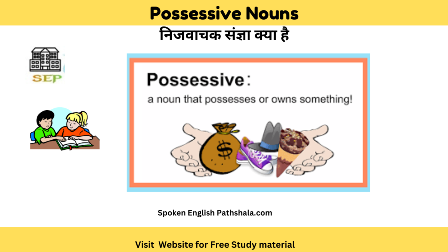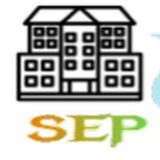Possessive nouns are nouns that show ownership or a specific relationship between one thing and another. They are used to indicate that something belongs to someone or something.
How to Form Possessive Nouns
- Singular Nouns: For most singular nouns, you form the possessive by adding an apostrophe (
') and the letters.- Example: John → John’s (John’s book)
- Plural Nouns Ending in
s: For plural nouns that already end ins, you usually form the possessive by adding just an apostrophe (').- Example: The teachers → The teachers’ lounge (the lounge belonging to the teachers)
- Plural Nouns Not Ending in
s: For plural nouns that do not end ins, you form the possessive by adding an apostrophe ands.- Example: Children → Children’s toys (the toys belonging to the children)
Examples of Possessive Nouns
Sarah’s book – Indicates that the book belongs to Sarah
John’s car – Indicates that the car belongs to John
Here are 35 examples of possessive nouns, along with sentences demonstrating their use:
| No. | English Sentence | Hindi Translation |
|---|---|---|
| 1 | This is Alice’s book. | यह एलेस का किताब है। |
| 2 | The dog’s collar is blue. | कुत्ते का कॉलर नीला है। |
| 3 | We visited John’s house yesterday. | हम कल जॉन के घर पर गए थे। |
| 4 | Mary’s dress is very stylish. | मैरी का ड्रेस बहुत स्टाइलिश है। |
| 5 | The children’s playground is closed for maintenance. | बच्चों का खेल का मैदान मरम्मत के लिए बंद है। |
| 6 | I need Tom’s help with this project. | मुझे इस परियोजना में टॉम की मदद चाहिए। |
| 7 | The teacher’s desk is in the corner of the room. | शिक्षक की डेस्क कमरे के कोने में है। |
| 8 | The cat’s toy is missing. | बिल्ली का खिलौना गायब है। |
| 9 | This is Susan’s car. | यह सुसान की कार है। |
| 10 | The bird’s nest is in the tree. | पक्षी का घोंसला पेड़ में है। |
| 11 | David’s laptop is on the table. | डेविड का लैपटॉप टेबल पर है। |
| 12 | The garden’s flowers are blooming. | बाग के फूल खिल रहे हैं। |
| 13 | I borrowed Jessica’s pen. | मैंने जेसिका की पेन उधार ली। |
| 14 | The company’s profits have increased this year. | कंपनी के लाभ इस साल बढ़ गए हैं। |
| 15 | Mike’s office is on the third floor. | माइक का ऑफिस तीसरी मंजिल पर है। |
| 16 | The neighbor’s dog barks loudly. | पड़ोसी का कुत्ता जोर से भौंकता है। |
| 17 | The library’s books are well-organized. | पुस्तकालय की किताबें अच्छी तरह से व्यवस्थित हैं। |
| 18 | Karen’s shoes are by the door. | कारेन के जूते दरवाजे के पास हैं। |
| 19 | The chef’s recipe was a hit. | शेफ की रेसिपी बहुत पसंद की गई। |
| 20 | Emma’s children are very polite. | एमा के बच्चे बहुत शिष्ट हैं। |
| 21 | The artist’s painting is displayed in the gallery. | कलाकार की पेंटिंग गैलरी में प्रदर्शित है। |
| 22 | The doctor’s advice was very helpful. | डॉक्टर की सलाह बहुत उपयोगी थी। |
| 23 | The movie’s plot was intriguing. | फिल्म की कहानी दिलचस्प थी। |
| 24 | Laura’s laptop was stolen from the café. | लौरा का लैपटॉप कैफे से चुराया गया। |
| 25 | The team’s strategy was successful. | टीम की रणनीति सफल रही। |
| 26 | Nancy’s room is very neat. | नैंसी का कमरा बहुत साफ-सुथरा है। |
| 27 | The river’s water level is rising. | नदी का पानी का स्तर बढ़ रहा है। |
| 28 | Lisa’s birthday party was a grand affair. | लिसा की जन्मदिन की पार्टी एक भव्य आयोजन थी। |
| 29 | The professor’s lecture was informative. | प्रोफेसर की व्याख्यान जानकारीपूर्ण थी। |
| 30 | Paul’s suggestion was taken seriously. | पॉल का सुझाव गंभीरता से लिया गया। |
| 31 | The child’s drawing is on the fridge. | बच्चे की ड्राइंग फ्रिज पर है। |
| 32 | Sara’s emails need to be checked. | सारा के ईमेल्स की जाँच की जानी चाहिए। |
| 33 | The president’s speech was very inspiring. | राष्ट्रपति की भाषण बहुत प्रेरणादायक था। |
| 34 | The neighbor’s garden is beautifully landscaped. | पड़ोसी के बाग को सुंदर तरीके से लैंडस्केप किया गया है। |
| 35 | Alice’s advice was crucial for the project. | एलेस की सलाह परियोजना के लिए महत्वपूर्ण थी। |

